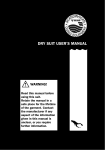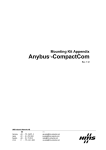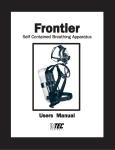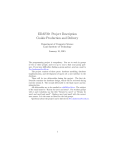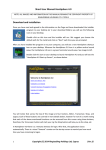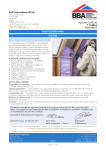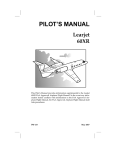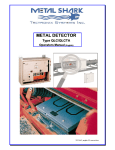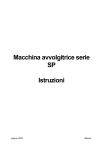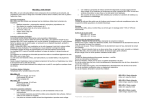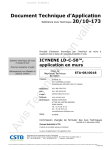Download DRYSUIT USER`S MANUAL
Transcript
DRYSUIT USER’S MANUAL WARNING! Read this manual before using this suit. Retain the manual in a safe place for the lifetime of the garment. Contact the manufacturer if any aspect of the information given in this manual is unclear, or you require further information. INTRODUCTION Welcome to this User’s Manual. It is intended for users of Viking drysuits. All procedures described in this manual require adequate skill and knowledge in the use of drysuits through training by a qualified and certified instructor. In the manual, risks to persons or equipment are indicated by the following types of notices: WARNING! A warning notice indicates a potentially hazardous situation which, if not avoided, may cause injury or death. Warning notices are designed in the style of this notice. CAUTION! A cautionary notice indicates a situation which may cause damage or malfunction to material or equipment. Cautionary notices are designed in the style of this notice. WARNING! Diving with a drysuit can be extremely dangerous. Do not attempt to use this drysuit without prior training and certification by a qualified and certified instructor, and use of all necessary and appropriate equipment. I 1 INTRODUCTION Table of Contents Safety instructions 1 INTRODUCTION These guidelines are recommended by Viking. Follow them for your safety and incorporate them in your routine as a mandatory predive check list. If your equipment fails to work as intended: DO NOT USE IT; HAVE THE PROBLEMS CORRECTED BY A QUALIFIED DIVE SHOP. Safety instructions _________________ III 1 INTRODUCTION Description ______________________ V Description of marking in the suit ____ VI 2 DRESSING Insulating clothing and equipment ____ 1 1 Complete a drysuit diving course led by a certified instructor and maintain proficiency by regular dives. 2 Use a buoyancy compensator device for surface flotation and for your safety. 3 Know your equipment and emergency procedures. Read the User's Manuals for all your equipment. 4 Practice your drysuit diving skills under controlled conditions until they become second nature. 5 Never dive alone. Dive with a buddy who has a thorough understanding of your drysuit system. Do always have people on land or in a boat that are able to help you in case of emergency. Installation of cuff rings _____________ 3 Pre-dive equipment checks __________ 4 Dressing instruction________________ 6 Check before entering the water ______ 8 Undressing _______________________ 10 3 REPAIRING A DRYSUIT Gluing, general rules _______________ 11 Pressure testing ___________________ 15 Gluing preparations ________________ 16 Gluing __________________________ 18 Patching _________________________ 21 4 MAINTENANCE Storage and maintenance ____________ 23 Valves ___________________________ 25 5 DRYSUIT DIVING Technique _______________________ 26 Valves ___________________________ 30 Hose ____________________________ 33 II WARNING! Risk of injury due to reduced body functions when diving in cold water. Water or air temperatures below 70°F (21°C) constitute cold water diving. Water or air temperatures below 40°F (5°C) constitute ice diving. Ice diving is dangerous and requires special equipment, training, preparation and procedures. III 1 INTRODUCTION 1 INTRODUCTION Safety instructions Description 6 Use the correct amount of insulation for the water conditions you are diving in and your exercise rate. 7 Your weighting should allow you to make a decompression at ten feet at the completion of your dive with a tank containing 500 psi of air or less. Determine the appropriate weight needed to attain neutral buoyancy by for example a pool dive. Weight yourself at neutral buoyancy with an empty tank. An increased salinity in the water requires more weight. A drysuit is a suit which protects its wearer by the exclusion of water and contaminants when underwater. Latex seals are attached to the body of the suit at the neck and cuffs to prevent water from entering whilst submerged. Various types of underwear can be worn under the suit depending on water temperature, depth and diver activity. The conservation of body heat using thermal protection, in cold, deep water is vitally important to the safety and efficiency of divers, professional and amateur alike. The following chapters describe in detail, how to use, maintain and carry out certain repairs to your drysuit. 8 Check your valves, hose, zipper and seals before each dive. 9 Perform preventive maintenance and repairs on the suit regularly. At least once a year have the suit, valves and hose serviced by a qualified dealer service, but more frequently if the suit is in heavy or extraordinary use. 10 Know your limitations and do not exceed them. WARNING! Risk of skin irritation and allergic reactions. The drysuit materials can cause skin irritation and allergic reactions to individuals sensitive to these materials. Consult medical advise if in doubt. WARNING! Do not use other gas than air for inflation of the suit. Using oxygen enriched gas for inflation one is in risk of fire and explosion. Using argon there is a risk of this gas getting into a full face mask and the breathing system through the hood. This has to be avoided because the effect of breathing argon is more narcotic than what nitrogen is when under increased partial pressure. WARNING! WARNING! Diving with a drysuit can be extremely dangerous. Do not attempt to use this drysuit without prior training and certification by a qualified and certified instructor, and use of all necessary and appropriate equipment. IV Risk of injury due to reduced body functions when diving in cold water. Water or air temperatures below 70°F (21°C) constitute cold water diving. Water or air temperatures below 40°F (5°C) constitute ice diving. Ice diving is dangerous and requires special equipment, training, preparation and procedures. V 1 INTRODUCTION Description of marking in the suit 1 1 Follow established diving safety practice. Do not dive over the limits of your ability and training. Do not use this suit without being familiar with diving equipment and having had prior qualified training. 3 4 7 WARNING! IMPROPER MAINTENANCE, USE OR MISUSE OF THIS DRYSUIT COULD RESULT IN SERIOUS INJURY OR DEATH. 13 2 5 INTRODUCTION 6 Do not use this dry suit until you have practised and mastered practical dry suit skills, including emergency skills in a controlled environment under supervision of a dive instructor certified by a nationally recognised instructional organisation and knowledgeable in the use of dry suits. 8 9 10 11 Do not use this suit without evaluating the conditions before every dive and making sure they fit your personal capabilities. Regularly service and maintain the suit and its parts! Check equipment before and during every dive. 12 Field 1: Brand name Field 2: Model. Field 3: CE-approval, year issued, by notified body (NB number). Field 4: CE-approval according to international standard or EEC directive. Field 5: Size. Field 6: Pictogram with measurements in centimetres. Field 7: Request to read instructions in User's Manual. Field 8: Washing instructions. Field 9: Article number of suit. Field 10: The suit's individual batch number. Field 11: Suit manufacturer. Field 12: Address suit manufacturer. Field 13: Warning text. (see page 5) VI The Viking suits have been tested and approved by notified body no. 0403; Finnish Institute of Occupational Health, Department of Physics, Topeliuksenkatu 41 a A, FIN-00250 Helsinki. The suits are CEmarked and have EC type approval under the Council Directive 89/686/EEC on personal protective equipment. Improper maintenance, use or misuse of this dry suit could cause loss of buoyancy control and exposure to thermal hazards, including uncontrolled descents and uncontrolled rapid ascents, body overheating or overcooling, resulting in drowning, decompression sickness, air embolism, stroke or seizure. Do not use this drysuit until you have read, understood and followed all instructions and safety precautions in the User´s Manual. Never dive without accepting your own responsibility for safety on every dive. If the User´s Manual is unavailable or lost, another copy can be obtained by writing the manufacturer or be downloaded from www.vikingdiving.com. VII 1 DRESSING DRESSING Insulating clothing and equipment 2 Thermal protection underwear In order to protect the diver from cooling, which could result in reduced body functions, it is highly important to dress correctly under the dry suit (A). The neck area and shoulders are very important to protect. Each individual has different abilities to preserve the body heat. Adjust your clothing, choice of type, thickness and amount of insulating layers after your activity level, weather and water temperature. Wear sports underwear (C) covering wrist to shoulder next to the body (B) and over this an insulating dress (D). It is of vital importance to have the right buoyancy for maximum insulating protection. Hoods The hood protects your head and neck from getting cold. Choose a proper hood, best fitted for the conditions where you dive. Gloves and mitts Keep your hands warm in order to be able to control your equipment during the dive. Use dry gloves or mittens, with separate liners, that together with cuff rings can connect to the suit. Gloves with wool liners will protect down to approx. +10°C. In colder water mittens or better insulated gloves are recommended. Note! See also the chapter on drysuit diving for more thorough information on how to adjust weights for the right buoyancy. WARNING! WARNING! Diving with defective equipment can cause injury or death. Do not dive if any equipment fails to function as intended. Have them repaired or replaced at an authorised dive shop. 1 Diving with new and unfamiliar equipment can be extremely dangerous. Always practise your drysuit diving skills with new equipment under controlled conditions, supervised by a qualified and certified instructor. 2 2 DRESSING Installation of cuff rings 2 1 Insert the inner ring Insert the plastic inner ring, with grooved edge first, down the sleeve until the forward edge rests under the latex cuff a little below the sleeve end. 2 Place the outer ring Slide the rubber outer ring over the latex cuff and inner ring, locking it into place by pressing it up and over the edge of the inner ring. The distal edges of both cuff rings will be even when they are properly seated. 3 Put on the gloves Put on the latex gloves and pull the rolled edge over the lip of the outer cuff ring to form a seal. Secure with a Viking rubber band. DRESSING Pre-dive equipment checks 1 Trim the seals The neck-seal on a new suit must be adjusted to fit the diver (approx 20% smaller than the circumference of the neck). Trim carefully in small increments using a long, sharp pair of scissors. Lubricate the seals with pure, unscented talcum powder when donning the suit so as to reduce friction against your skin. WARNING! Failure to trim the neck-seal may result in choking, leading to injury or death. 2 Connect the inflator hose to the valve Check visually to make certain that there is no damage or contamination to the connector house, valve head, hose or O-rings. WARNING! Do not use other gas than air for inflation of the suit. Using oxygen enriched gas for inflation one is in risk of fire and explosion. Using argon there is a risk of this gas getting into a full face mask and the breathing system through the hood. This has to be avoided because the effect of breathing argon is more narcotic than what nitrogen is when under increased partial pressure. WARNING! Diving with defective equipment can cause injury or death. Do not dive if any equipment fails to function as intended. Have them repaired or replaced at an authorised dive shop. 3 4 2 DRESSING DRESSING Dressing instruction 2 3 Check the valve function Connect air to the inlet valve and operate the valve. Check that the valve opens and closes properly. The suit will inflate if the valve is working properly. 4 Check the zipper Check that the zipper opens and closes properly and that no material, such as underwear fiber or lint, is caught in the zipper’s teeth. Check that the zipper is free from dirt and sand. Lubricate the zipper if necessary. Use only lubricant recommended by Viking and the zipper manufacturer. Silicon spray is dangerous to your zipper and suit. Note! See also the chapter on maintenance for more thorough information on how to lubricate the zipper. 5 Assembly of hose to low pressure port The inflator hose must be connected to a LOW pressure port on the regulator's first stage or to another source of low pressure air. Maximum working pressure is 15 BAR (225 psi.). The inflator hose is manufactured with UNF 3/8" coupling. Note! Avoid sharp bends in the hose: Do not bend the hose below a minimum radius of 4 cm (1.5") 6 Stiff latex in cold weather use Cold and low temperatures make the latex parts stiff and brittle. Warm them up gently with something that keeps a temperature of +37°C to +40°C to make them smooth and easy to put on, just before use. 5 1 Take off all jewellery It is important to remove all rings, watches and necklaces and other items which could tear the latex seals. CAUTION! Sharp objects can tear the suit material, with risk of leakage or malfuntion. Remove all sharp objects. 2 Step into the suit feet first This may be easier to do from a sitting position. 3 Adjust the cuffs Put your arms, one at a time, through the sleeves and slide your hands into the latex cuffs so the seals are smoothly seated on your wrist. Pull the suit material if necessary, but avoid pulling directly on the latex, particularly with the finger nails. 6 2 DRESSING DRESSING Check before entering the water 2 4 Pull the hood over your head Put your hands from the outside of the hood and neckseal. Pull apart and slide the hood onto your head. 5 Adjust the neckseal and hood Adjust the neckseal by folding it smoothly downwards around your neck. Make certain there are no wrinkles or folds which could allow water to enter. Also adjust the hood around your face so that your mask will attach to your face skin only. Make certain there is no hair or thermal innerhood sticking out under the hood. 6 Close the zipper Make sure that the person who closes your zipper is careful not to catch any underwear material in the zipper teeth. 7 Connect the inflator hose Make certain that the inflator hose does not interfere with the operation of or access to any other equipment. 7 1 Connect the inflator hose to the valve Check that the inflator hose is properly connected to the valve. Check for damage and contamination. 2 Inflate the suit Inflate the suit so you feel air entering the suit. 3 Vent exhaust air Open the outlet valve by turning the valve lid counter clockwise, and bend down to force excess air out of the outlet valve and ensure that it functions properly. 4 Close the outlet valve Close the valve by turning the lid clockwise. WARNING! Diving with defective equipment can cause injury or death. Do not dive if any equipment fails to function as intended. Have them repaired or replaced at an authorised dive shop. 8 2 DRESSING DRESSING Undressing 2 5 Depress the valve Release air from outlet valve by depressing the valve, to make sure the valve is functioning. 1 Disconnect inflator hose Disconnect the inflator hose before removing other equipment. 2 Open the zipper If the zipper sticks do not force it. Investigate the problem and remove obstacles. 6 Check the zipper Let your diving buddy check that your zipper is properly closed. 7 Always wear a buoyancy aid Always wear a separate buoyancy compensator, or buoyancy aid (BCD). 8 Finally check the water condition again before entering the water 3 Before taking off a latex hood Put your hands inside the suit between the neckseal and your neck. Push out the latex and pull over your head. 4 Take off the hood Grasp the neck-seal through the face opening and pull hood and neck-seal over the head. Pull the suit material but avoid pulling the latex directly, particularly with the finger nails. 5 Release latex cuffs Release cuffs by gripping the material of the suit and pull in a smooth and easy movement. Pull the suit material, if necessary, but avoid pulling the latex directly, particularly with the finger nails. 6 WARNING Falling into water with the drysuit open can cause injury or drowning, since the drysuit will quickly be filled by water. Always keep the suit zipper properly closed when you are near deep water or on a boat. 9 Step out of the suit Note! Information on how to take care of the suit after diving is given in the chapter on MAINTENANCE. 10 2 REPAIRING A DRYSUIT REPAIRING A DRYSUIT Gluing, general rules 3 Wherever possible, drysuit repairs should be undertaken by a qualified drysuit repair service. If the drysuit owner undertakes any repairs, the following procedures should be followed to ensure that proper techniques are employed. Repairing a drysuit Do not inhale glue or hardener. See warnings in this manual and on glue container. Use only glue recommended by Trelleborg. Other types of glue may damage the suit material. For minor repair (patching) use glue (polyurethane suits) or vulcanisation solution (rubber suits) supplied with the Trelleborg repair kit. Gluing preparation Ensure damaged area is dry. Clean the surface to be glued. Remove remains of old loose glue, oil and grease. Thoroughly sand down all new dry suit parts where they will be glued. Clean sanded area with heptane or white gas. Gluing Apply a thin layer of glue on both surfaces to be glued. Let dry for 15 minutes. Apply a second layer of glue and let dry a minimum of 15 minutes or until tacky. 11 Neutralizing Neutralize excessive glue by applying unscented talcum powder. Curing Curing time will vary with room temperature. At 20°C (68°F) a minimum of 60 minutes is required, but the repair area should not be stressed for 3 hours and will be fully cured in 24 hours. If possible, avoid using the suit for 24 hours after a major repair. 2 1 3 1 2 3 4 Cloth tape Suit material coated side Fabric Latex 4 12 3 REPAIRING A DRYSUIT 3 How to mix the Trelleborg 2component glue Immediately before use, the hardener should be mixed thoroughly with the glue. Add 1 part hardener to 10 parts glue. (Use the measuring cup provided.) The mixed glue can be used only as long as it is fluid, approximately 2 hours. REPAIRING A DRYSUIT Tools for repairs These wooden tools are handy equipment for major repairs of latex parts. A. Cylinder with spherical top: for changing of latex hoods and neckseals. B. Topped cone: for changing of latex cuffs. All measurements in cm and inches. WARNING! The glue and hardener may be harmful to your health by inhalation or skin contact or contact with your eyes. Read warning note below and follow the instructions on the kit. WARNING! Hardener – Harmful Contains Diphenylmethane - 4,4 - Diisocyanate and Ethylacetate. Contains Isocyanates; See information supplied by the Manufacturer. Harmful by inhalation. Irritating to eyes, respiratory system and skin. May cause burning sensation by inhalation. In case of contact with eyes rinse immediately with plenty of water end seek medical advice. In case of accident or if you feel unwell seek medical advice immediately. (Show label where possible.) Use only in well ventilated conditions. Glue – Harmful – Highly flammable Harmful by inhalation. Contains Toluene and Butanone. Irritating to eyes and respiratory system. Keep container in a well ventilated place. Keep away from sources of ignition – No smoking. Do not breathe fumes. Avoid contact with eyes. Do not empty into drains. Take precautionary measures static discharges. 13 14 3 REPAIRING A DRYSUIT REPAIRING A DRYSUIT 3 Pressure testing Gluing preparations Pressure Testing To determine the position of a leak/damaged area of the suit, carry out a pressure test as follows: Wherever possible, drysuit repairs should be undertaken by a qualified drysuit repair service. If the drysuit owner undertakes any repairs, the following procedures should be followed to ensure proper techniques are employed. 1 Seal openings Seal neck opening, by for example placing a suitable-sized ball in the neck-seal. Make sure the seal stretches and grips the ball. Seal cuffs, by for example placing an empty plastic bottle in each of the cuffs making sure the latex grips the bottles. 2 Inflate and find leaks Inflate the suit and locate the leak by using soapy water or by partial submergence of the suit in water. Mark the leak with a chalk before deflating the suit. Verify repairs After repairs, allow 3 hours for curing, and then carry out another pressure test to ascertain the integrity of the suit. CAUTION! Risk of damage to the suit material due to over inflating. Do not over inflate the suit. 15 1 Remove the tape On suits with tape around the latex cuffs, remove tape by using cleaning solvents. Use heptane or white gas. WARNING! Risk of eye injury from contact with solvent. Wear proper eye covers to protect your eyes. 2 Remove the cuff Pull latex until old glue releases. 3 Sand new latex Sand new latex 20 mm (3/4”) on inside, and when using tape, 12 mm (1/ 2”) on outside as well. Sand also suit sleeve 25 mm. 16 3 REPAIRING A DRYSUIT REPAIRING A DRYSUIT Gluing 3 4 Clean with solvent Clean all surfaces to be glued. Use heptane or white gas. 1 Apply two layers of glue Apply two layers of glue with 15 minutes drying time for each layer, both on the inside of the new latex cuff and on the outside of the sleeve. 3 WARNING! Risk of eye injury from contact with solvent. Wear proper eye covers to protect your eyes. 17 2 Attach the new latex cuff Use a bottle or a round piece of wood inside the sleeve as a form to ease the installation of the new latex cuffs. Apply the new latex cuff. Avoid streching the latex cuff. Attach by using two opposite points and work your way around one side at a time. (Pull it loose and begin again if it becomes uneven). There must be no folds or creases, the latex should lie smoothly along the cuff. When the latex is properly attached, secure it by pressing firmly with the roller. 18 REPAIRING A DRYSUIT REPAIRING A DRYSUIT 3 3 When using tape, apply two coats of glue to the area it will cover, on the outside. 6 Verify repairs After repairs, allow 3 hours for curing, then carry out a pressure test to ascertain the integrity of the suit, as described in the section on Pressure testing. 3 7 4 Apply tape Apply the tape half on suit and half on latex cuff to cover the joint between latex and suit material. Smooth with a roller. Overlap cloth tape. Service your suit and its parts on regular basis Let an authorised Viking dealer service your drysuit, valves, inflator hose, zipper and seals on regular basis and for more complicated repairs. At least one service a year must be undertaken, but more frequently if the suit is in heavy or extraordinary use. 5 Apply talcum powder Neutralize excessive glue with unscented talcum powder, espewcially on the inside of the latex part. CAUTION! Risk of severe damage to the drysuit or its equipment leading to malfunction, if the suit is not properly serviced. Service must be undertaken, even if the suit is not in regular use. 19 20 REPAIRING A DRYSUIT REPAIRING A DRYSUIT Patching 3 1 Locate the leak Carry out a pressure test as described in the section on Pressure testing. 2 Cleaning/Sanding The suit must be dry. Wash hands: oil and grease must be removed. Clean damaged area by rubbing with sand paper and remove loose particles. Apply three layers of glue, allowing 15 minutes drying time per layer. 3 Patching Choose a suitable sized patch and remove the backing. Apply vulcanisation solution (rubber suits) or two layers of glue (polyurethane suits) on the patch and the suit. Allow to dry and apply the patch to cover the damaged area. 21 4 Fixing the patch Use a roller over the glued area to press out any air bubbles and to make sure the surfaces are firmly bonded. Pay special attention to the areas where the glued parts cross over tape. 5 Talcum powder (rubber suits only) Neutralize excessive solution with unscented talcum powder. 6 Verify repairs After repairs, allow 3 hours for curing, then carry out a pressure test to ascertain the integrity of the suit, as described in the section on Pressure testing. 22 3 MAINTENANCE MAINTENANCE Storage and maintenance CAUTION! 4 Risk of severe damage to the drysuit or its equipment leading to malfunction, if the suit is not properly stored and maintained. Follow the instructions in this chapter. 1 Clean the suit Rinse with fresh water, or a mild soap solution. Do not forget to rinse valves, as described in this chapter. 6 Store the suit Fold sleeves around the suit. Put the suit in the bag and close it carefully. CAUTION! Risk of severe damage to drysuit parts made of rubber, leading to leakage and taring, if the suit is exposed to ozone or solvents. The drysuit must be stored away from light, with no ozone generators (electrical equipment) or chemical solvents present. 2 Dry the suit before storage To dry the inside, wrap the suit inside out, if necessary. 3 Use unscented talcum powder on latex parts Do not use silicone lubricants. 4 Lubricate the zipper The only acceptable lubricant is the one recommended by Viking and the zipper manufacturer, a fluid and a wax. Apply the fluid to the inner elements. Use wax sparingly. Close and open the zipper carefully, twice. Under no circumstance should silicone spray be used on the zipper or any other portion of the suit. SILICONE 5 Roll up the suit Roll up the suit, starting with the feet. The zipper should be open during storage. 23 24 4 MAINTENANCE 4 DRYSUIT DIVING Valves Technique 1 Maintenance outlet valve After each dive rinse with fresh water to make sure no salt, sand or other particles are trapped in the sealing surface. 1 Before you go into the water Before you go into the water, put on the drysuit as described in the chapter on Dressing. Make sure all equipment is in place and fully functional. 2 Maintenance inlet valve After each dive rinse the inlet valve and the inflator hose with fresh water. Keep the valve and hose connected and pressurised while rinsing with fresh water. Inspect the valve and hose, making sure no dirt is stuck between the housing and push button. 3 Check that valves are functioning To check if the valves are functioning, inflate suit with inlet valve and release air manually through the outlet valve. Check that each valve opens and closes properly. 4 Service your suit on a regular basis Let an authorised Viking dealer service your suit and its parts, valves, inflator hose, zipper and seals on a regular basis. At least one annual service must be undertaken, but more frequently if the suit is in heavy or extra-ordinary use. 2 Go into the water Enter the water feet first, with the outlet valve closed and with a little air in the suit to assure positive buoyancy for surface flotation. 3 Check buoyancy for proper weighting Empty your separate bouyancy compensation device/buoyancy aid (BCD). See your BCD manual. Open the valve completely by turning the valve lid counter clockwise. Raise the valve to the highest point allowing air to exhaust. WARNING! CAUTION! Risk of severe damage to the drysuit or its equipment leading to malfunction, if the suit is not properly serviced. Service must be undertaken, even if the suit is not in regular use. 25 Diving with a drysuit can be extremely dangerous. Do not attempt to use this drysuit without prior specialized training and certification by a qualified and certified diving instructor. Use all necessary and appropriate equipment. 26 5 DRYSUIT DIVING 5 DRYSUIT DIVING 4 Weights Add weight until you are slightly negative (0.5-1.0 kg (1-2 lbs) heavier than neutral). Normally the diver will need 8-14 kg (18-30 lbs) of weight depending on the type of underwear worn, diving equipment used, and type of diving being done. Remember to add the weight you will need to compensate for the weight you will lose through consumed tank air. Your weighting should allow you to make a decompression at ten feet at the completion of your dive with a tank containing 500 psi of air or less. You should now be properly weighted. 8 Descending If you wish to descend, roll over on your right side so the outlet valve (and left shoulder) is at the highest point, allowing the valve to exhaust some air. Your buoyancy will decrease and you will slowly sink. Stop your descent To prevent further venting of suit air return to normal swimming position and, if necessary, add a little air to the suit to regain neutral buoyancy. 5 Allowing you to descend When you are ready to descend, open the outlet valve (turn the lid counter clockwise). Raise your upper left arm so the outlet valve is at the highest point allowing suit air to exhaust. Slow your ascent While ascending, or swimming towards shallow water, the outlet valve will release expanding suit air in proportion to the decrease in ambient pressure. If you are properly weighted, you should be able to control your rate of ascent simply by raising or lowering your upper left arm and the exhaust valve. To slow your ascent, lift your upper left arm so the valve is at the highest point and can exhaust air freely. 6 Relieve suit squeeze When you have descended a couple of metres (yards), turn the valve lid clockwise 1/4 turn and add as little air to the suit as needed to relieve suit squeeze. 7 Gain neutral buoyancy While swimming at the same depth, you do not have to adjust the outlet valve. Gain neutral buoyancy and swim relaxed. 27 9 Ascending Additional venting If additional venting is necessary, fully open the valve counter clockwise or the valve can be manually depressed to obtain the same result. 28 5 DRYSUIT DIVING DRYSUIT DIVING Valves 5 Extra lift during ascent If you want extra lift during ascent, simply lower the valve by bringing your upper left arm to your side. If further lift is needed, turn the valve lid slightly clockwise. Inflator valve free flowing If the inflator valve starts to free flow at an uncontrolled rate, disconnect the inflator hose. Emergency ascent If you are unable to inflate the suit or if the suit is leaking air, dump the weight belt to gain positive buoyancy. 10 On the surface On the surface immediately close the outlet valve by turning it clockwise and add a little air to the suit for flotation. In rough conditions you may need buoyancy aid on the surface. Use your separate buoyancy compensator/aid, rather than adding extra air to the suit. WARNING! Do not use other gas than air for inflation of the suit. Using oxygen enriched gas for inflation one is in risk of fire and explosion. Using argon there is a risk of this gas getting into a full face mask and the breathing system through the hood. This has to be avoided because the effect of breathing argon is more narcotic than what nitrogen is when under increased partial pressure. 1 Outlet valve Our patented outlet valve is located on the upper left arm of the suit within easy reach of the right hand for adjustment, as well as for automatic air dumping when the diver is upright. It is located well out of the way of harnesses and other equipment. On ascent, providing the diver is properly weighted and the valve is properly adjusted, the outlet valve dumps air automatically to maintain perfect buoyancy control and helps to prevent an uncontrolled ascent. A properly adjusted valve will give you handsfree buoyancy control. The outlet valve can be adjusted to maintain the positive pressure inside the suit. Air can also be dumped at any time by depressing the valve lid. WARNING! Risk of valve malfunction which may result in unability to ascend during dive, if the valve is tampered with. The outlet valve does not contain any user serviceable parts. Replacement should be made by your authorised dealer. WARNING! WARNING! Risk of fatal injury from air embolism or decompression sickness, due to rapid ascent. Do not attempt to use your suit as a lifting device. Dropping the load may cause uncontrolled and rapid ascent. 29 Diving with defective equipment can cause injury or death. Do not dive if any equipment fails to function as intended. Have them repaired or replaced at an authorised dive shop. 30 5 DRYSUIT DIVING 5 2 Increase Buoyancy To increase buoyancy - simply lower the outlet valve and add a small amount of air to the suit, or turn the outlet valve lid clockwise, which will increase the pressure setting, and add a small amount of air to the suit. 3 Decrease buoyancy To decrease buoyancy - simply raise the outlet valve (by lifting yor left upper arm), or turn the valve lid counter clockwise, which will reduce the pressure setting. By depressing the valve lid, air can be dumped at any time, regardless of the pressure setting, providing the valve is at the highest point of the suit and the suit air has free access to the outlet valve. DRYSUIT DIVING 4 Inflator valve The Viking inflator valve is operated by an easy to reach large push button. It is a oneway valve, which prevents the escape of suit air from the suit, if the inflator hose is disconnected from the valve. The valve can be easily removed for cleaning and maintenance. Should it become clogged with mud or salt, flush it thoroughly with water and blow it dry with air from the suit inflator hose. Only non aerosol silicone lubricants should be used on the inflator valve and only in the hole of the male connector. CAUTION! The manufacturer does not guarantee the function of the valve mounted in other types of suits. The valves and hoses are designed to work together, and cannot be used separately or together with other valve types. WARNING! Diving with defective equipment can cause injury or death. Do not dive if any equipment fails to function as intended. Have them repaired or replaced at an authorised dive shop. CAUTION! The manufacturer does not guarantee the function of the valve mounted in other types of suits. The valves and hoses are designed to work together, and cannot be used separately or together with other valve types. 31 32 5 DRYSUIT DIVING Hose 1 5 Assembly of hose to low pressure port The inflator hose must be connected to a LOW pressure port on the regulator's first stage or to another source of low pressure air. Maximum working pressure is 15 Bar (225 psi). The inflator hose is manufactured with UNF 3/8" coupling. 2 Storage of hose Avoid bending the hose too sharply. Do not bend the hose below the minimum radius of 4 cm (1.5"). 33 © Trelleborg Protective Products AB. 0306 Trelleborg Protective Products AB P.O. Box 1520, SE-271 00 Ystad, Sweden Phone: +46 411 67940, Fax: +46 411 15285 E-mail: [email protected] www.vikingdiving.com

























